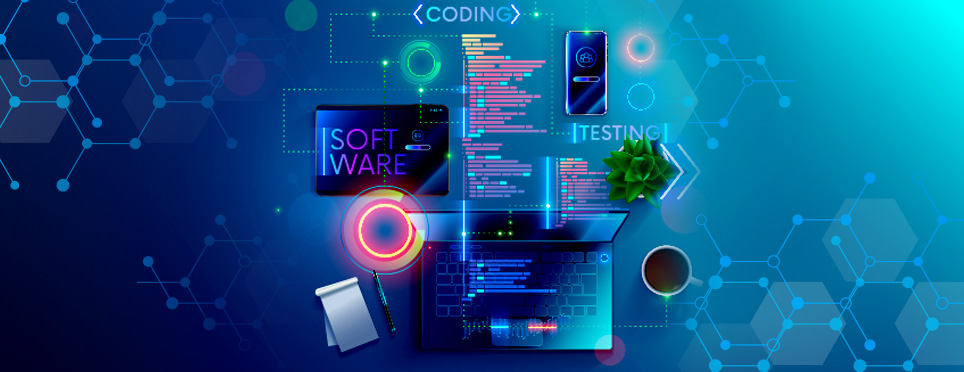Home » Environmental Testing: Minimizing Disruption & Downtime
INSIGHTS
Intelligent solutions. Informed decisions. Unrivaled results.

Environmental Testing: Minimizing Disruption & Downtime
Today we are in the midst of an app economy aided by the rise of open banking and embedded finance, and with shifting consumer choices - there are many applications that are revolutionizing the banking and the financial and capital markets ecosystem but ensuring more customer centricity.
But despite the buzz, many fail to live up to the expectations. This leads to the question - why do unforeseen complications crop up even in a perfectly good high-quality app?
Considering that speed and accuracy are the holy grail of software testing, software developers and QA (quality analysts) leave no stone unturned to validate results and ensure that the performance of the application is top-of-class, the application is free of bugs, and the safety and security of the software is not compromised.
But if they are not testing the networks, hardware, and communicating interfaces – the APIs (Application Programming Interfaces) or the environment thoroughly, they leave behind inadmissible gaps that could have unforeseen consequences in the way the app functions. With the cloud gaining prominence, one needs to be more vigilant when it comes to testing.
Environmental Testing – Key Elements and Dependencies
Unlike earlier, the complexity of an application has increased manifold times. There are multiple dependencies that must be considered, especially with the cloud in the picture. While earlier, software testing could be carried out in isolation, that is simply not enough today because how the application functions in real-time cannot be assuaged by looking at the deployment environment and its components and carrying out tests in isolation. We need to take the entire environment into consideration. So, the following dependencies/components must be tested as comprehensively and thoroughly for ensuring smooth functioning, reliability, and compatibility.
- Operating system: Windows, Linux, Android, etc.
- Database or data management and storage: As database instability can have far- reaching consequences, organizations must be thorough with the testing. Today, organizations are predominantly using cloud databases along with Oracle, IBM DB2, SQL Server, and MySQL for the same purpose.
- Hardware dependency is another critical component that must be tested.
- The APIs (Application programming interfaces) and networking interfaces, and end-user computing – or the user experience.
Some Common Use Cases of Environmental Testing
Some of the common use cases for environmental testing are as follows:
- Implementing new tools or memory upgrades for servers,
- Testing new patches or updates in the system
- Security fixes and software updates
Overall, comprehensive testing of the environment would be required in the following instances.
Test Environment Infrastructure: Test environment is one extremely crucial aspect of Environmental testing which must not be overlooked at any cost as it plays a vital role in ensuring quick go-to-market.
- Planning tools: IT (Information Technology) development teams set up the test environment for regular and quick releases, they also finalize test tools for testing planning, design, and execution, and also for monitoring, eliminating, and reporting the bugs.
- Documentation: Testing documentation is also a good best practice for keeping everyone in the same loop and for better understanding of what the team is trying to achieve.
Server/Client Infrastructure: testing the functionality of servers – virtual, proxy, mail, file, web whether in-prem or cloud - and the client's Environmental performance.
Network Testing: Managing resource usage, server downtime, appropriateness of system configuration, Operating system patches.
Installation and Uninstallation Testing: ensure no issues during installation, uninstallation, and deployment.
Data Migration Testing: Data migration testing is the testing of data when it has been migrated from the old system to a new system, say from on-prem to the cloud with minimal disruption or downtime, while guaranteeing data integrity and no loss of data. It also means that all the specified functional and non-functional features of the application function as-is post- migration. Pre- and post-migration testing are essential constituents of data migration testing as well as rollback testing and backward compatibility testing.
Infrastructure Testing in Cloud: When moving to the cloud for optimization of effort, time and resources, it is absolutely necessary to ensure that no loose ends remain.
Challenges of Environmental Testing
A rapidly evolving IT landscape, changing firmware, OS, browser, etc., are the biggest pain points in infra testing.
- Installer packages for building the application
- Additional libraries and the build packages
- Time taken in installing and uninstalling the application
- Checking for space in disk testing
- Finding out if all files are deleted or removed after the application has been uninstalled
- Lack of standardization when it comes to defining Environmental testing
- Manual infra testing is mundane and repetitive and error prone
- Results in low level of code as it is not always possible to scale according to the market
- Results in poor user experience, and does not subscribe to the principles of AGILE and DevSecOps
- Failure to investigate the test environment issues and follow-up
- Maintaining a storehouse of test environments and the versions in one place poses a concern in the absence of proper documentation.
- With test environments and teams remotely located, it is difficult to have a clear picture of the difficulties that arise w.r.t the various dependencies
- Siloed work culture which results in code testing at the end of lifecycle.
What will you achieve if you do Environmental Testing?
- Environmental testing prevents bugs and issues from slipping through which can later escalate into matters beyond control.
- Makes defect identification better before production execution. Enhances the quality of infrastructure by ensuring zero defect slippage to production.
- Minimizes the risks of production failures and ensuing downtime and poor customer experience.
- Infra testing confirms that the dependencies are sound, and the app is functioning as expected in a systematic and controlled manner.
Environmental testing on the whole is a niche domain requiring multiple levels of testing.
Magic FinServ Client Success Story
For one of our clients, a leading investment solutions provider, which was facing an all-too- familiar problem - lack of documentation or zero documentation, we improved documentation by defining goals with minimum disruption and downtime. There were other challenges as well such as frequent changes in the application, but these were managed successfully as well. From setting up agile processes from scratch and R&D on tool selection and carrying out testing from day 1 as there were frequent changes in the application and integrating it (the application) with CI/CD for a noticeably faster go-to-market. The tools that we used included Java, Selenium WebDriver, TestNG, and Maven.
By considering the operational environment first, and leveraging an environment-based approach to testing, software testers can make sure that everything is in place to make testing productive and efficient. Rather than spending time trying to test applications in isolation or with a pseudo-realistic environment, testers can spend more time on the actual testing itself.
Testing is vital for ensuring how an application performs in the long run and hence it is always advisable to dedicate a good amount of effort to ensure that all possible aspects such as functionality, security, performance, availability, and compatibility, are tested as thoroughly as possible. For more information on how you can optimize the performance of your application and reduce downtime and disruption, you can visit our website, or write to us at mail@magicfinserv.com so that we can set up a call or guide you through.


